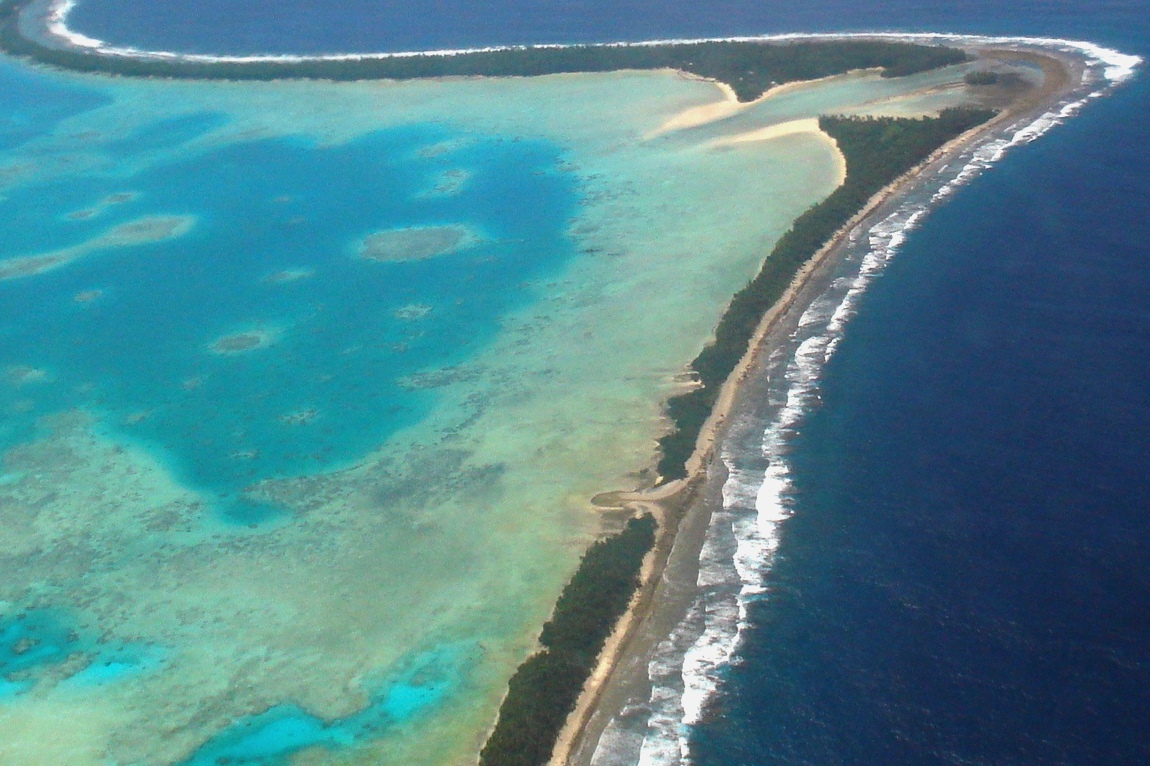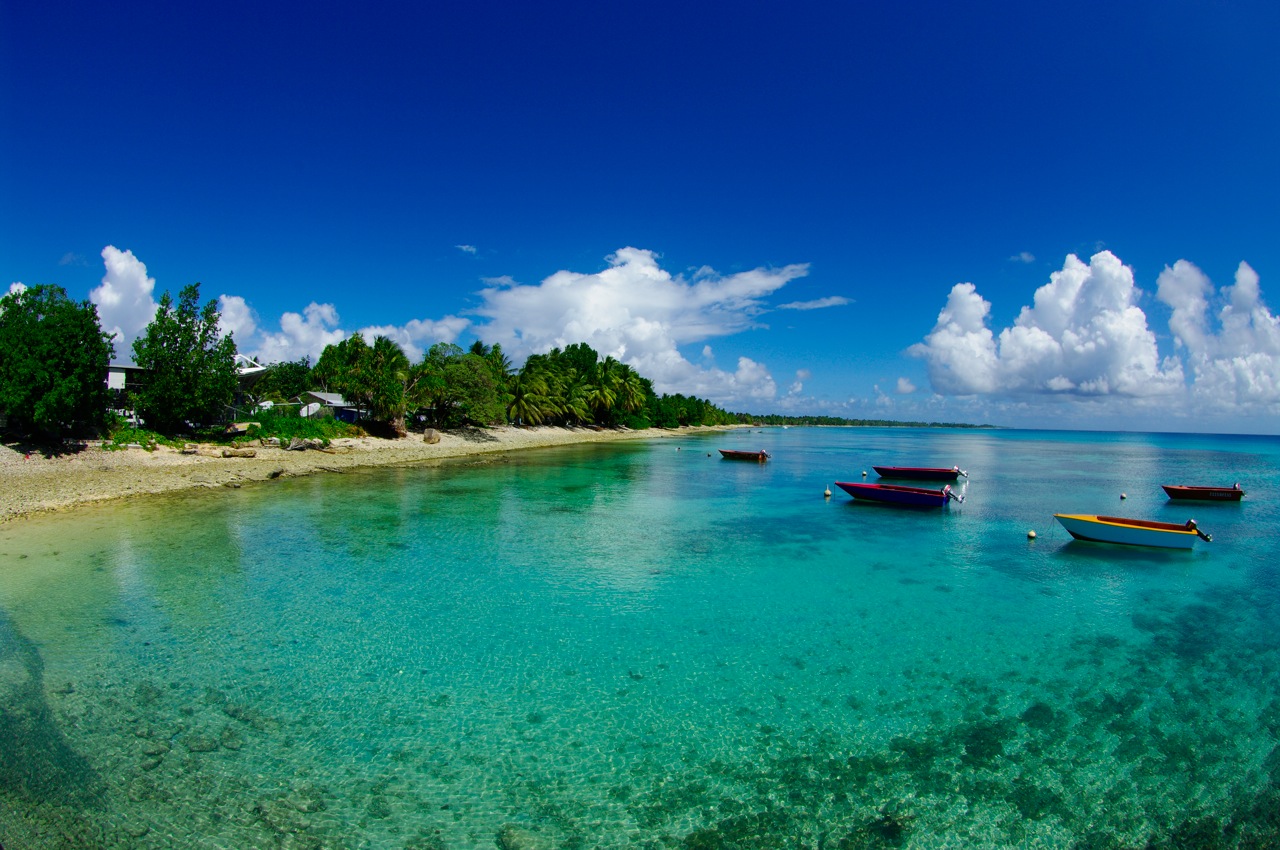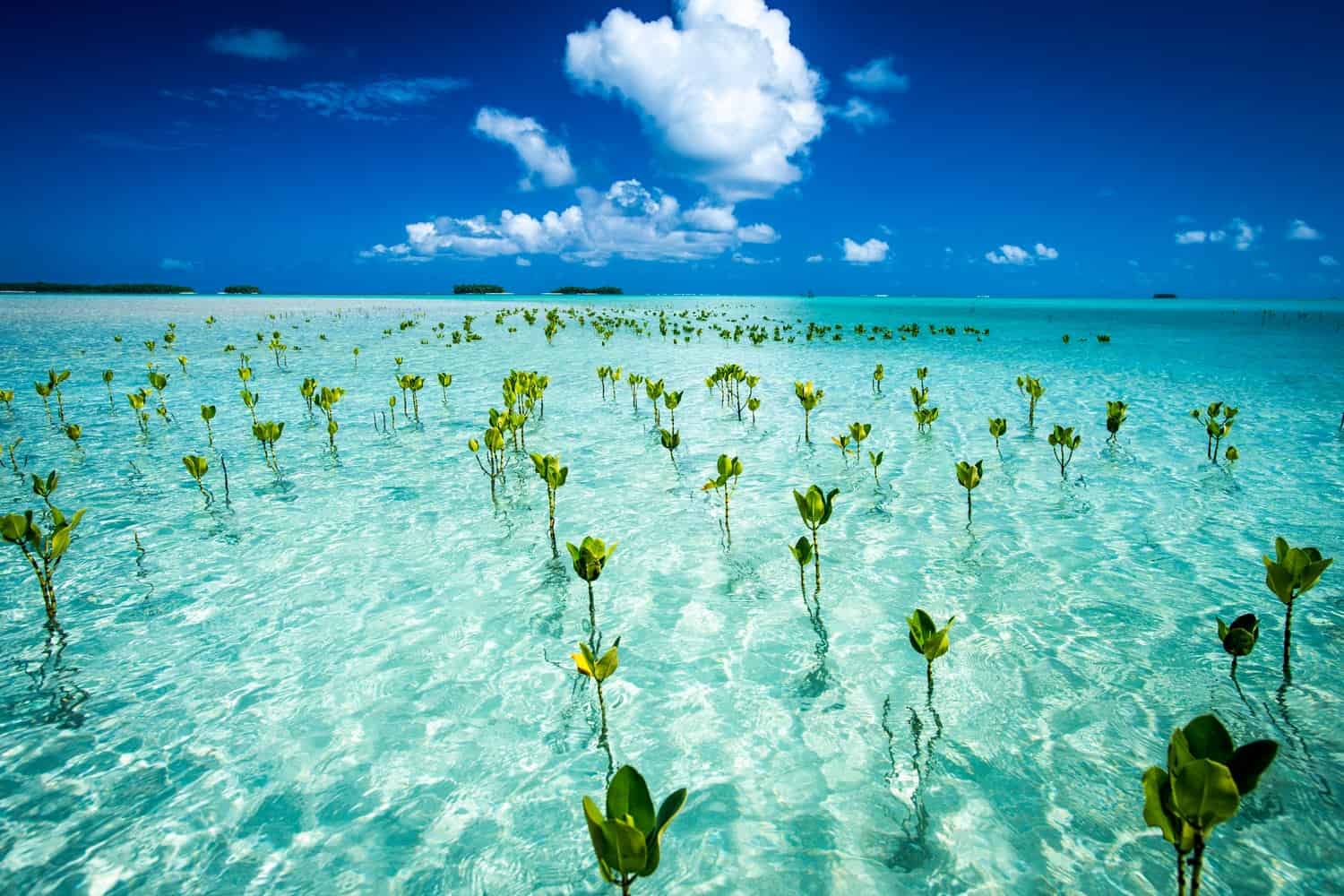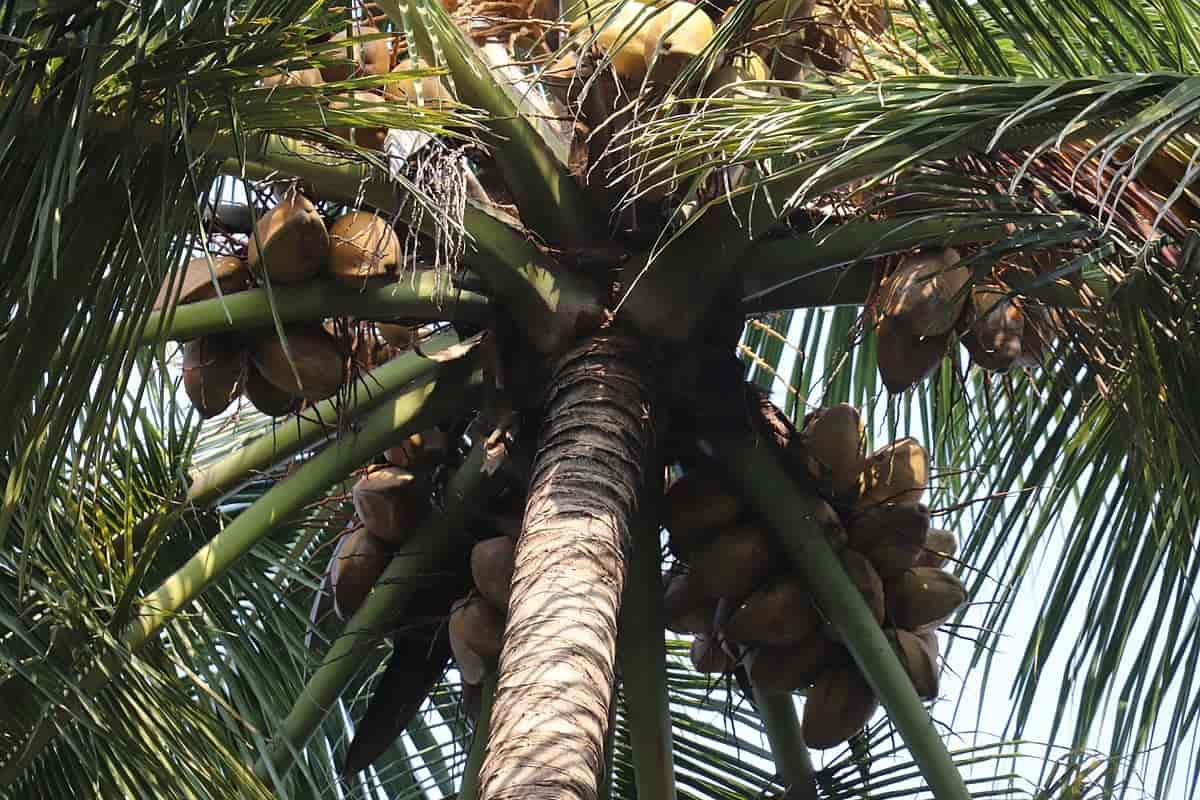Timeless Tuvalu
Six atolls and three reef islands of Tuvalu are south of Kiribati and north of Fiji. The total area is less than 25 km2 (10 mi2), and the highest peak is only 16 ft, but the length of the island chain is 676 km.
Because of global warming, sea levels are rising, and this threatens all of the low-lying Tuvalu Islands. According to the Antarctic Cooperative Research Centre, Australia, an estimated rise of 20-40 cm in the next 100 years could make Tuvalu uninhabitable. The country implements many actions aimed at its survival in the future.
The entire population consists of 11,900 people (as of 2021), a large part of which reside in the capital of Tuvalu, Funafuti.
The total number of islands and islets (small unnamed islands) in Tuvalu is as many as 124, with each island being surrounded by a coral reef. Despite this large number, Tuvalu is the fourth-smallest country in the world.
The largest islands and atolls include Nukulaelae (land area 1.82 km2, 300 ppl as of 2017), Funafuti (2.4 km2, 6,320 ppl), Vaitupu (5.6 km2, 1,061 ppl), Niulakita (0.4 km2, 34 ppl), Nukufetau (2.99 km2, 597 ppl), Niutao (2.53 km2, 582 ppl), Nui (2.83 km2, 610 ppl), Nanumanga (3 km2, ppl), and Nanumea (3.87 km2, 512 ppl). At least 11 islands are inhabited.
History

The Tuvalu Islands are believed to have been inhabited approximately 3000 years ago. Initially, 8 of 9 largest islands were inhabited, which explains the origin of the name «Tuvalu», which means «eight standing together» in Tuvaluan. Traditional Tuvaluan society lived in isolation from the rest of the world until the 1820s when European traders arrived.
In 1877, Tuvalu, then known as the Ellice Islands, came under British jurisdiction and became a colony in 1892. Colonial administration remained in Tuvalu as part of the British Western Pacific Territories until 1916, when the Gilbert and Ellice Islands colony was established.
From 1896 to 1898, the Coral Reef Committee of the Royal Society carried out three expeditions aimed at investigating coral reef formation at Funafuti. Drilling equipment was used to take core samples of the coral reef. The first bore reached 31 m (100 ft), the second was 170 m (557 ft), and the third was 340 m (1,114 ft). The third expedition proved successful, and four stages in coral reef development were discovered.
During the Second World War, Tuvalu were used as a base for the United States Marine Corps, which landed on Funafuti in October 1942 and on Nukufelau and Nanumea — in August 1943. Seaborne attacks on Kiribati islands were prepared there, as Kiribati had been earlier invaded and occupied by the Japanese forces. Airfields were built on Funafuti, Nanumea and Nukufelau. Besides, Naval Base Funafuti was constructed, where American boats and seaplanes were stored from November 1942 to May 1944. After the war, Funafuti's military airfield was transformed into an international airport.
In 1975, Tuvalu gained independence and, on October 1, 1978, joined the commonwealth as the 38th member — the country's Independence Day. Today, Tuvalu is considered one of the world's least developed yet most peaceful states. On November 10, 2023, the country signed a treaty, Falepili Union, with Australia addressing climate change and security. According to the treaty conditions, Australia will let 280 Tuvaluan citizens migrate annually as a means of climate-related mobility (the possible future flooding of the islands mentioned above).
Know before a visit

Tuvalu uses the Australian currency, the Australian dollar. Remember that there are no credit card services throughout the islands, so you should carry either cash or chequebooks.
Telephone services, both local and international, and the Internet are available, though the latter is said to be slow.
Departure tax is 30 AUD per person.
As for clothes, women shouldn't wear swimsuits and such in villages.
There is only one hospital in Tuvalu — Princess Margaret Hospital. It is situated on Funafuti and offers all general medical services.
Two spoken languages are Tuvaluan and English.
You should use water sparingly during your visit because the country has no fresh water sources and relies entirely on rainwater storage.
The climate is tropical, with a wet season from November to April. Due to their low elevation, islands are highly susceptible to cyclones and king tides (high tides higher than average). Since 2016, Tuvalu has had a satellite-based warning system against natural disasters.
How to get to Tuvalu

Fiji Airways operates a flight between Suva, Fiji, and Funafuti thrice a week — on Tuesdays, Thursdays and Saturdays. The flight takes 2.5 hours, departing at 09:20 and arriving at 11:50.
Air Kiribati also provides a flight once a week. The plane takes off from Tarawa at midday on Wednesday and arrives in Funafuti at 3 p.m. The plane's capacity is 35 people; tickets cost over $350 one way.
The only port in Tuvalu is Funafuti; there is also a deep-water berth at Nukufetau.
Transportation

The most used kind of transport is motorbikes, which are widely available and rather cheap. Bicycles, motorboats and cars can also be hired. On weekdays, minibuses operate. Sometimes, hotels may provide you with a means of transport; if not, the staff recommends some rentals. Lastly, due to the islands' small sizes, it is quite possible to get around on foot.
Heritage

A traditional community system still exists in Tuvalu. Each family is given a specific task (salanga) — fishing, house-building, etc. This promotes the transfer of skills through generations of a family.
The traditional island meeting hall is called falekaupule or maneapa. In such houses, islanders discuss important matters, host wedding ceremonies, and hold community events. One of those is fatele — a gathering involving music, dancing, and singing.
The traditional decision-making body, which exists on each island, is the council of elders, falekaupule.
The establishment of the first museum in Tuvalu — Tuvalu National Cultural Centre and Museum — is planned for the near future.
Traditional sports of Tuvalu are kilikiti, similar to cricket, and te ano (translated as «the ball»), similar to volleyball.
Funafuti Marine Conservation

Founded in 1999, this institution aims to protect marine and land biodiversity. The protected area consists of 33 km2 (12,74 mi2) of reefs, islets, and lagoons, which is 20% of the total coral reef area of Funafuti lagoon. It is populated by various corals, fish, invertebrates, and algae, including some endangered species.
Activities

Tuvalu is a perfect place for diving and snorkelling. Moreover, these activities are allowed in the territory of the Funafuti Marine Conservation mentioned above. There are no dive shops and no operators on the islands, but facilities may be found in some hotels. Ask the staff to show you some good spots, and they will gladly direct you.
Yachting is one of the most exciting ways to explore Tuvalu. Rent a yacht or a catamaran and enjoy excursions around the islands, or spend some hours fishing — a good day guaranteed!
If you enjoy exploring cultures, you should see a traditional Tuvaluan dance (fakaseasea, fakanau, fatele)! On the island, there are two nightclubs, Matagigali and Tefota, that are open on weekends. Local town halls, called Maneapa, host cultural events and ceremonies throughout the year. Once again, consult with your hotel staff to inform yourself about the upcoming events.
In a 10-minute' boat ride from Funafuti lies Afelita Island. For 70 Australian dollars a day, you can have a whole island at your disposal! The offer also includes a chef who will cook you traditional Tuvaluan dishes from freshly caught fish and locally grown vegetables.
Attractions

David's Drill on Funafuti, Fongafale village, is a site of scientific research conducted in the 1800s to test Charles Darwin's theory of atoll formation. It postulated that all coral atoll foundations are volcanoes. The deepest bore reached 928 feet but didn't reach volcanic rock. Though the experiment had failed, modern science proved Darwin's correctness.
Tuvalu National Library and Archives is the only library on the Tuvalu Islands. It was established in 1978 after Tuvalu gained independence from Great Britain. Those who visited it say that some rarities may be found there.
Tuvalu Women's Handicraft Centre
The biggest centre is next to the airport, and smaller ones are stranded across the outer islands. You can choose from various fans, baskets, woodcarvings, necklaces, fishhooks, and mats in those stalls.
Tuvalu Philatelic Bureau
The building is located at the southern end of the town of Funafuti. Stamps depicting Tuvalu have been highly popular worldwide since 1975. Then, Tuvalu became an independent constitutional monarchy, having been separated from what is now called Kiribati.
Tuvalu Mangrove Planting
In the lagoon of Nanumea Atoll, there is a two-acre mangrove nursery. One thousand seedlings have been growing there for ten years, occupying one kilometre of the coastline. The Tuvalu National Council of Women (TNCW), together with the Tuvalu Association of Non-Government Organisations (TANGO), proposed the project to plant and replant mangroves and Beauty Leaf Laurel on the outer islands. The purpose of this project is to raise money for handicraft centre refurbishment and to protect Tuvalu from tidal and storm erosion.
Caves of Nanumanga (or Nanumanga Fire Caves)
The cave was discovered in 1986 by scuba divers from New Zealand who had heard a local legend about a house under the sea. It's sometimes referred to as Fire Cave because of some signs of habitation — dark patches of fire on the walls and charred coral fragments on the floor. Now, the cave lies 37 to 46 m below sea level. Surprisingly, the sea level was that low about 8,000 years ago; however, according to the archaeological evidence, the first settlers came here approximately 3,000 — 3,500 years ago.
Accommodation

Funafuti Lagoon Hotel (Vaiaku Lagi Hotel) is located in the centre of the town of Funafuti, only 50 metres from the airport. Room windows offer lagoon views and thus are amazing spots for watching sunsets.
Esfam Lodge is a family-owned complex that has 16 rooms, situated in a 3-minute walk from the airport and most of the town institutions. All the rooms have been renovated and are described by the owners as comfortable and clean. Choose Esfam Lodge to feel true Tuvaluan hospitality.
L's Lodge is situated in a community neighbourhood where you can immerse yourself in Tuvaluans' daily life. Rooms are self-contained and private; however, a living room and a kitchen are communal. Activities and entertainment are available on a demand basis.
The peaceful family-run hotel Flamona Lodge has existed since 1998. The airport's runway is at the back of the building; in the afternoon, you may go there to watch or participate in community activities.
Talofa Serviced Apartments is on the aforementioned Afelita Island, a small islet on the northern side of Fonfagale, the island's capital. The serene resort, owned by the Afelee family, welcomes its guests.
Have an unforgettable vacation in timeless Tuvalu!
